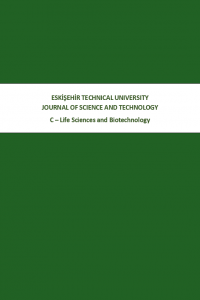BİR PROTON POMPASI İNHİBİTÖRÜ OLAN PANTOPRAZOLUN İNCE BARSAK PANETH HÜCRELERİ ÜZERİNE ETKİSİ
Pantoprazol, Mukozal immünite, Paneth hücreleri, Enterokromafin hücreler, Mast hücreleri, Polimorf nükleer ve globül lökositler
EFFECT OF PANTOPRAZOL A PROTON PUMP INHIBITOR ON SMALL INTESTINAL PANETH CELLS
Pantoprazole, mucosal immunity, paneth cells, enterochromaffin cells, mast cells, globule and polymorphous leukocyte,
___
- Blandizzi, C., Natale, G. and Gherardi, G. (2000). Gastroprotective Effects of Pan- toprazole Egaints Experimental Mucosal Damage. Fundamental Clinical Pharma- cology 14, 89-99.
- Bliesath, H., Huber, R. and Hartmann, M. (1994). Dose Linearity of The Pharmaco Kinetics of The New H/K ATPase Inhibi- tor Pantoprazole After Single Intravenous Administration. International Journal of Clinicial Pharmacology Ther.; 32(1), 44- 50.
- Drossman, D.A. (2006). Fonksiyonel Gastroin- testinal Bozukluklar ve Roma III Süreci. Gastroenterology Türkçe Baskı 2, 135-51.
- Fitton, A. and Wiseman, L. (1996). Pantoprazole Areview of its Pharmacological Properties and Therapeutic Use in Acid-Related Disorders. Drugs 51(3), 460-482.
- Kidd, M., Modlin, I.M. and Eick, G.N. (2006). Isolation, functional characterization, and transcriptome of Mastomys ileal enteroch- romaffin cells. American Journal of Physiology Gastrointestinal and Liver Physiology 291(2), 778–91.
- Özbek, E. and Eşrefoğlu, M. (1999). The structural and histochemical features of the glands within the duodenum of rabbit and the rat. Turkish Journal of Gastroen- terology 10(2), 126-31.
- Peterson, W.L. (1995). The Role of Acid in Upper Gastrointestinal Haemorrhage due to Ulcer and Stress-related Mucosal Damage. Aliment Pharmacol Ther 9 Suppl 1, 43-6.
- Ouellette, A.J. (1999). Mucosal Immunity and Inflammation IV.Paneth Cell Antimicro- bial Peptides and The Biology of The Mucosal Barrier. American Journal of Physiology Gastrointestinal and Liver Physiology 277(2), 257-261.
- Sachs, G., Shin, J.M. and Briving, C. (1995). The Pharmacology of The Gastric Acid Pump: The H, K ATPase. Annual Review Pharmacology and Toxicology 35, 277- 305.
- Schworer, H., Katsoulis, S. and Racke, K. (1992). 5-hydroxytryptamine release from the porcine small intestine: Involvement of H3 receptors. Gastroenterology 102(6), 1906-12. inhibits
- ISSN: 2667-4203
- Yayın Aralığı: Yılda 2 Sayı
- Başlangıç: 2010
- Yayıncı: Eskişehir Teknik Üniversitesi
ALABALIK ÜRETİMİ YAPILAN AKPINAR DERESİ (DENİZLİ) SU KALİTESİNİN DEĞERLENDİRİLMESİ
Cafer BULUT, Ufuk AKÇİMEN, Ramazan KÜÇÜKKARA, Soner SAVAŞER, Kazim UYSAL, Esengül KÖSE, Cem TOKATLI
DÜNYA DIŞI ORTAMLARIN MİKROBİYAL YAŞANABİLİRLİK AÇISINDAN DEĞERLENDİRİLMESİ
Betül BULUÇ, Mustafa YAMAÇ, Metin ALTAN
BİR PROTON POMPASI İNHİBİTÖRÜ OLAN PANTOPRAZOLUN İNCE BARSAK PANETH HÜCRELERİ ÜZERİNE ETKİSİ
